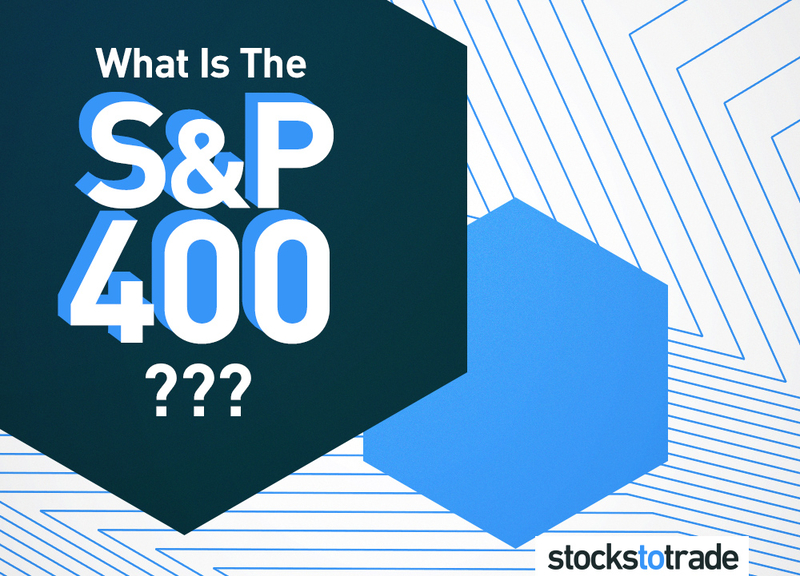Nope: the title of this post isn’t a typo…
While most traders are familiar with the S&P 500, today we’re talking about its lesser-known younger sibling, the S&P 400.
Where the S&P 500 index is a weighted index of the 500 largest U.S. companies that are publicly traded, the S&P 400 index focuses on midcap companies.
Curious to learn more about this midcap market index? You’re in the right place. In this post, we’ll discuss all things S&P 400, including what it is, how it works, how to track it, and how to trade its related ETFs.
Table of Contents
What Is the S&P 400?
The S&P 400, which is officially titled the Standard & Poor’s Midcap 400 Index, is a market capitalization-based market index.
It’s brought to you by the S&P Dow Jones Indices, aka the same folks who brought you the S&P 500. This index focuses on U.S.-based midcap companies and is the most-followed midcap index in the world.
What Is a Market Index?
In case you’re not familiar with what a market index is, let’s briefly go over that before moving forward.
A market index is a representational portfolio of holdings that shines a spotlight on a particular section of the market.
The value of the index comes from the prices of the holdings being tracked. An index might be calculated by market cap, revenue, stock float, or other stock fundamentals.
What’s the Difference Between the S&P 500 and the S&P 400?
Before we go any further, let’s differentiate the 400 index from its more-famous sibling, the S&P 500.
The S&P 500 is a market-cap weighted index of the 500 biggest public companies in the U.S.
The key differences between the 400 and 500? The size of the company and the size of the index list. The S&P 500 is comprised of 500 large cap companies; the 400 is comprised of 400 midcap companies.
What the S&P 400 Tells You
In general, market indexes are considered a benchmark of the market within the section covered by the index. For example, by monitoring the S&P 400 index, you can get a pretty good overview of how midcap companies are performing at this time in the market.
That is to say: the S&P 400 is a good barometer of midcap US equities in general.
Criteria for the S&P 400
How does a midcap stock gain the coveted velvet rope entry into the S&P 400?
Like the S&P 500, the S&P 400 is calculated based on market capitalization. To be considered for the index, a stock needs to have a market cap between $1.6 and $6.8 billion.
So… what kinds of companies will this include? Many stocks on the S&P 400 index are household names, coming from a variety of major industries. Some examples? American Eagle Outfitters, Domino’s Pizza, Dunkin’ Brands Group Inc, Energizer Holdings Inc, and — here’s a favorite — World Wrestling Entertainment.
Weighing the S&P 400
When taking the S&P 400 into consideration as a metric of the health of midcap companies, it’s important to remember that it’s an average based on a variety of different company types and sizes.
Additionally, as with any index, the stocks that have the biggest market cap within the list of 400 companies will carry the biggest weight, where the ones toward the smaller end of the list will have a smaller impact on the movement of the index at large.
This is to say: Consider the S&P 400 as part of your stock research, but don’t rely solely on what it tells you.
Tracking and Trading the S&P 400
Want to trade the S&P 400?
While market indexes are not directly traded, there are a number of ETFs that track the S&P 400. These can be traded.
Put simply, while the actual index itself cannot be traded, you can track and trade ETFs that are chosen and based around S&P 400 companies. You can buy shares of these ETFs on the NYSE Arca Exchange.
Wait, what’s that? The NYSE Arca, which used to go by ArcaEx or Archipelago Exchange, is an exchange where you can trade ETFs and equities.
On this exchange, there are a variety of differently curated ETFs that follow the S&P 400, including:
General S&P 400 Index ETFs
- iShares Core S&P Midcap ETF ( IJH)
- SPDR S&P Midcap 400 ETF (MDY)
- Vanguard S&P Midcap 400 ETF ( IVOO)
Growth S&P 400 Index ETFs
- iShares S&P Midcap 400 Growth ETF (IJK)
- SPDR S&P 400 Midcap Growth ETF (MDYG)
- Vanguard S&P Midcap 400 Growth ETF (IVOG)
Value S&P 400 Index ETFs
- iShares S&P Midcap 400 Value ETF (IJJ)
- SPDR S&P 400 Midcap Value ETF (MDYV)
- Vanguard S&P Midcap 400 Value ETF (IVOV)
Interested in giving these ETFs a try? They can all be traded and researched on StocksToTrade.
StocksToTrade
Want to make the most of your trading time? There are two necessary ingredients: a proper education, and the right research tools.
Created by traders, StocksToTrade was designed to help traders like you perform the detailed research that’s so vital to forming strong watchlists and trading plans.
Here are just a few of the features the platform has to offer:
- The ability to scan over 18,000 stocks across all the major U.S. exchanges.
- Streamlined charting, so that you can track price action and seek out patterns in all the stocks you follow.
- A paper trading module so that you can test out strategies and practice trading without putting real money on the line while you get up to speed.
- The ability to track company news, SEC filings, and social media links right from the platform!
- Broker integration, so that you don’t have to toggle from screen to screen–execute trades right from the StocksToTrade platform.
Ready to see what STT can do for you? Take advantage of our 14-day trial of StocksToTrade today!
Do you keep track of the S&P 400 or any of the other S&P indexes? How do you use the information in your trading? Leave a comment and let us know!




